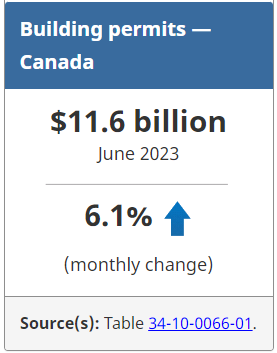Statistics Canada: Building Permits June 2023
The total monthly value of building permits in Canada increased 6.1% in June to $11.6 billion, with a notable 67.2% monthly increase (+$619.3 million) in the institutional component.
On a constant dollar basis (2012=100), the total value of building permits went up 7.0% to $6.8 billion.
Hospital construction intentions lead gains in non-residential permit values
The total monthly value of non-residential permits increased 20.4% to $4.7 billion in June. Declines in the commercial construction intentions (-7.7% or -$176.0 million) were more than offset by gains in the industrial (+51.0% or +$349.9 million) and institutional (+67.2% or +$619.3 million) components.
The two highest-valued permits in June were issued for the construction of new hospitals in Vaudreuil-Dorion, Quebec and Dawson Creek, British Columbia, which together totalled 58.6% of the total value of institutional construction intentions.
Residential permits stall despite monthly increases in seven provinces
The total monthly value of residential permits declined 1.8% to $6.9 billion in June. Ontario (-11.4% or -$358.1 million) contributed the most to the decline, falling off after the province posted strong volumes of large multi-unit projects in May. Similarly, Saskatchewan (-51.4% or -$58.5 million) and New Brunswick (-20.5% or -$20.7 million) posted notable declines, mostly offset by gains in each of the remaining seven provinces.
Across Canada, permits for 22,000 new dwellings were issued in June.
Second quarter of 2023 declines compared with first quarter of 2023
The total value of building permits in the second quarter declined 1.0% from the first quarter to $32.2 billion, as the non-residential sector fell 9.6% to $12.0 billion, following the first quarter’s record high for the sector.
Despite the overall decline, the residential sector broke a three-quarter slump, increasing 4.9% in the second quarter to $20.3 billion. Year over year, the value of construction intentions in the residential sector remained below the level seen in the second quarter of 2022 ($24.2 billion).
Similarly, 64,400 dwelling units were created in permits issued in the second quarter of 2023, 2.7% more than in the first quarter (62,700 units), with British Columbia leading the quarterly gains (+24.4% or +2,700 new units). Nationally, new dwelling units created in the second quarter were 14.7% below the number of dwellings created in the second quarter of 2022 (75,400 units).
To explore data using an interactive user interface, visit the Building permits: Interactive Dashboard.
For more information on construction, please visit the Construction statistics portal.
For more information on housing, please visit the Housing statistics portal.
Statistics Canada has a Housing Market Indicators dashboard. This web application provides access to key housing market indicators for Canada, by province and by census metropolitan area. The indicators are updated automatically with new information from monthly releases, giving users access to the latest data.
Note to readers
Unless otherwise stated, this release presents seasonally adjusted data with current dollar values, which facilitate month-to-month and quarter-to-quarter comparisons by removing the effects of seasonal variations. For information on seasonal adjustment, see Seasonally adjusted data – Frequently asked questions.
With this release, the indexes used for the deflation process were enhanced as part of a methodology review to increase the quality of the constant dollar and seasonally adjusted series. They previously displayed a step pattern due to lower frequency collection.
Building components
- Single-family dwellings: Residential buildings containing only one dwelling unit (e.g., single-detached house, bungalow, linked home [linked at the foundation]).
- Multi-family dwellings: Residential buildings containing multiple dwelling units (e.g., apartment, apartment condominium, row house, semi-detached house).
- Industrial buildings: Buildings used in the processing or production of goods or related to transportation and communication.
- Commercial buildings: Buildings used in the trade or distribution of goods and services, including office buildings.
- Institutional and government buildings: Buildings used to house public and semi-public services, such as those related to health and welfare, education or public administration, and buildings used for religious services.
Revision
Data are subject to revisions based on late responses, methodological changes and classification updates. Unadjusted data have been revised for the previous month. Seasonally adjusted data have been revised for the previous three months.
For information on trend-cycle data, see the StatCan Blog and Trend-cycle estimates – Frequently asked questions.
Next release
Data on building permits for July will be released on September 7.
Source: Statistics Canada


